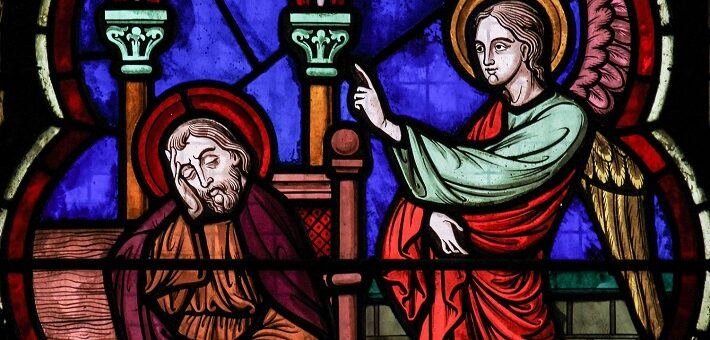Commentary on Matthew 1:18-25
At the beginning of the Gospel of Matthew, the author presents an account of the birth of Jesus. Unlike Luke’s Mary-centered account of Jesus’ birth, Matthew focuses of Joseph, Jesus’ adoptive father.
Joseph’s agency is foregrounded. His first inclination was to dissolve his engagement to Mary rather than have her legally punished for having conceived a child that was not his. Mary’s pregnancy must have caused Joseph a great deal of pain. His hoped-for fiancée was pregnant, and all he knew was that the child was not his.
But God was with Joseph. An angel spoke to Joseph and consoled him. Mary had not cheated on him, and he was still allowed to marry her. Indeed, the only change in their relationship was that they did not have marital relations until after she gave birth (Matthew 1:25). More than that, however, Joseph would be entrusted with caring for and naming the child. The Hebrew name from which we extract “Jesus” means “The LORD saves.” Joseph was to name the child this because he would save his people from their sins.
Jesus was not the only meaningful name that was applied to the child in this passage, however. The author of the gospel included a parenthetical reference to explain that this all happened to fulfill the prophecy that a virgin would conceive and give birth to a son who would be called Immanuel (God with us). The Greek here occludes more than it helps, in my opinion. We must look back to the prophecy that the gospel writer references.
In Isaiah 7, the kingdom of Judah was under attack by the northern kingdom of Israel and the allied kingdom of Aram. Isaiah and his eldest son went to the king of Judah and told him to request any sign of his choosing that things would work out for the southern kingdom. King Ahaz refused to choose a sign, so God said that a specific young woman soon would conceive and give birth to a child. Before the child was old enough to know right from wrong, the cities of the kings that threatened Judah would be in ruins.
The prophecy was not unalloyed, however. By the time the child did know the difference between right and wrong, he would be eating milk and honey. These foods, normally associated with the fecund productivity of the land (see Exodus 3:17, Deuteronomy 31:20), in this case alluded to a cessation of normal agriculture because of a siege by the Assyrians (Isaiah 7:17).
The woman in Isaiah’s prophecy would name the child Immanuel, which means “God is with us” in Hebrew. The verb “is” is important. The child referenced in the original prophecy was probably Isaiah’s second son. Rashi, the medieval Jewish commenter, reads continuity between the prophecy of the young woman conceiving in Isaiah 7 and the prophet announcing in Isaiah 8:3 that he made love to his wife, also a prophet, and she conceived a son.1
Whoever the child was in Isaiah 7, he was to be a sign, but was certainly not “God with us.” His mother prophesied in naming him “God is with us.” The message that “God is with us” would be true when the kingdoms of Aram and Samaria were laid waste and Judah was saved. The message that “God is with us” would be no less true when the Assyrians laid siege to Judah and her citizens were killed and enslaved. God is with us not just in times of deliverance, but in times of devastation.
The author of the gospel of Matthew was writing to a mostly Jewish audience after the fall of the Second Temple in 70CE. God’s home on earth had been destroyed. The city of God’s presence had been overwhelmed by Romans. Thousands of Matthew’s readers’ friends and relatives had been brutally killed, hundreds of them by crucifixion on purposefully sadistic Roman crosses. The world and the future did not look good for Jews, or even the small but growing Jesus movement.
In this context, the gospel author reminded his readers of a prophecy about a child born hundreds of years earlier whose birth foretold both deliverance and destruction. The gospel author argues that Jesus’ birth fulfilled that ancient prophecy more than even its original context. Yes, the temple had been destroyed, but Jesus’ incarnation testifies that God is with us!
Just as Joseph’s hope for the future had been crushed by learning that his fiancée was pregnant with someone else’s child, so Matthew’s readers’ hopes for the future had been crushed by the utter devastation of the physical center of God’s kingdom on earth. But Christians have been reminded throughout the ages that Jesus is not just “God with us” (as if that were not enough) but also the living reminder that “God is with us.” So that even though Jesus sits at the right hand of God and does not walk physically with us, his title reminds us that in times of deliverance and in times of suffering both, God is with us.
Notes:
- (Gary Smith. “Isaiah 1-39” New American Commentary. Vol 15A [Nashville: B&H Publishing. 2007]. 202).
PRAYER OF THE DAY
God of promise, you made a commitment to Joseph that you would make Jesus a savior to all. Renew your commitment with us, so that all may know the saving grace of your son, Jesus. We pray these things in the name of Jesus Christ, our Savior and Lord. Amen.
HYMNS
All earth is hopeful ELW 266
Peace came to earth ELW 285
Joy to the world ELW 267, H82 100, UMH 246
CHORAL
I look from afar, Palestrina/Shephard


December 23, 2018